An Experimental Investigation on the Effect of Ferrous Ferric Oxide Nano-Additive and Chicken Fat Methyl Ester on Performance and Emission Characteristics of Compression Ignition Engine
Abstract
:1. Introduction
Motivation and Objective of the Study
2. Materials and Methods
2.1. Biodiesel Preparation
2.2. Ferrous Ferric Oxide (FFO) Nano-Fuel Additives
2.3. Preparation of Fuel Samples
2.4. Experimental Setup and Methodology
= √(0.52 + 0.42 + 0.42 + 1.52 + 1.42 + 1.52 + 0.92 + 0.82) = ±2.91%
3. Result and Discussion
3.1. Carbon Monoxide (CO) Emission
3.2. Unburned Hydrocarbon (UHC) Emission
3.3. Oxides of Nitrogen (NOx)
3.4. Smoke Emission
3.5. Brake Thermal Efficiency (BTE)
3.6. Brake Specific Fuel Consumption (BSFC)
3.7. Brake Specific Energy Consumption (BSEC)
3.8. Exhaust Gas Temperature (EGT)
4. Conclusions
- Engine operated with non-nano-additive blends produces significantly lower emissions of CO, UHC and smoke, whereas NOx emission found to be increase with increasing CFME concentration in blend. In addition, BTE is lower with CFME blend, due to lower calorific value of CFME unquestionably thereby higher BSFC and higher BSEC got attain for those blends.
- The dilution of nanoparticles in CFME blends further reduces the CO, UHC, and smoke emission. Besides, NOx emission also found to be reducing for nano-additive fuels. In addition, BTE was noted to be increased, while BSFC and BSEC observed to be decrease for those nano-additive blends in comparison to neat tested blends.
- Among all three concentrations of FFO nanoparticles, 100 ppm concentration offered the optimum result of performance (BTE, BSFC, BSEC, and EGT) and emission (CO, UHC, NOx, and smoke) characteristics with all CFME blends.
- The incorporation of 100 ppm dosage into CFME blends enhanced the vaporization process, which led to lower physical ignition resulting in efficient combustion (higher efficiency and lower emissions).
- Beyond 100 ppm concentration, engine performance starts to decrease and deleterious emissions also start to elevate due to decrease in activated catalytic surface, which is the result of particles agglomeration.
- Maximum decrements in CO by 56.66%, UHC by 22.72% and smoke by 15.64% noted for B30FFO100 nano-fuel in comparison with B30 blend. However, engine efficiency is higher by 6.15% than B30; nevertheless, it is lower by 3.6% than PD.
- Maximum reductions in BSFC by 10.64%, BSEC by 9.44% and EGT by 19.47% are noticed for B20FFO100 in comparison of B20 blend. Besides, maximum reduction in NOx emission by 15.39% is also observed for this nano-fuel blend. BTE is improved by 4.84% for B20FFO100 compared to B20. However, increment in BTE for B20FFO100 fuel is lower than B30FFO100 fuel; nevertheless, it is quite close to the PD.
- From analysis of all experimental results, it can be concluded that B20FFO100 among all nano-additive fuels provides the maximum performance results and optimum emission outputs in the diesel engine.
- Higher dosage of FFO nanoparticles in fuel starts to agglomerate that reduces surface to area volume ratio as a result in decreasing the catalytic activity of nanoparticles. Besides, a higher dosage of nanoparticles also increases the viscosity and density of fuel, resulting in deprived atomization. Therefore, the performance of high dosage doped nano-additive fuel was reduced.
- The utilization of FFO nanoparticles with pure diesel fuel can reduce the emissions (CO, UHC, NOx, and smoke), and significantly improve the performance of CI engine. Nonetheless, an investigation needs to be done to obtain the validated information.
Author Contributions
Funding
Institutional Review Board Statement
Informed Consent Statement
Data Availability Statement
Conflicts of Interest
Nomenclature
| CFME | Chicken fat methyl ester/biodiesel |
| FFO | Ferrous ferric oxide |
| PD | Pure diesel |
| KOH | Potassium hydroxide |
| ppm | Parts per million |
| B10 | 10% biodiesel + 90% pure diesel |
| B10FFO50 | 10% biodiesel + 90% pure diesel + 50 ppm FFO |
| B10FFO100 | 10% biodiesel + 90% pure diesel + 100 ppm FFO |
| B10FFO150 | 10% biodiesel + 90% pure diesel + 150 ppm FFO |
| B20 | 20% biodiesel + 80% pure diesel |
| B20FFO50 | 20% biodiesel + 80% pure diesel + 50 ppm FFO |
| B20FFO100 | 20% biodiesel + 80% pure diesel + 100 ppm FFO |
| B20FFO150 | 20% biodiesel + 80% pure diesel + 150 ppm FFO |
| B30 | 30% biodiesel + 70% pure diesel |
| B30FFO50 | 30% biodiesel + 70% pure diesel + 50 ppm FFO |
| B30FFO100 | 30% biodiesel + 70% pure diesel + 100 ppm FFO |
| B30FFO150 | 30% biodiesel + 70% pure diesel + 150 ppm FFO |
| BMEP | Brake mean effective pressure |
| A/F | Air fuel ratio |
| CO | Carbon monoxide |
| UHC | Unburned hydrocarbon |
| NOx | Oxides of nitrogen |
| BTE | Brake thermal efficiency |
| BSFC | Brake specific fuel consumption |
| BSEC | Brake specific energy consumption |
| EGT | Exhaust gas temperature |
| CA | Crank angle |
| HSU | Hartridge smoke unit |
References
- Conti, J.; Holtberg, P.; Diefenderfer, J.; LaRose, A.; Turnure, J.T.; Westfall, L. International Energy Outlook 2016; U.S. Energy Information Administration: Washington, DC, USA, 2016; Volume 0484, ISBN 2025866135. [Google Scholar]
- Yuvarajan, D.; Babu, M.D.; Beemkumar, N.; Kishore, P.A. Experimental investigation on the influence of titanium dioxide nanofluid on emission pattern of biodiesel in a diesel engine. Atmos. Pollut. Res. 2017, 9, 1–6. [Google Scholar] [CrossRef]
- Manigandan, S.; Gunasekar, P.; Devipriya, J.; Nithya, S. Emission and injection characteristics of corn biodiesel blends in diesel engine. Fuel 2019, 235, 723–735. [Google Scholar] [CrossRef]
- Atabani, A.E.; Shobana, S.; Mohammed, M.N.; Uğuz, G.; Kumar, G.; Arvindnarayan, S.; Aslam, M.; Al-muhtaseb, A.H. Integrated valorization of waste cooking oil and spent coffee grounds for biodiesel production: Blending with higher alcohols, FT–IR, TGA, DSC and NMR characterizations. Fuel 2019, 244, 419–430. [Google Scholar] [CrossRef]
- Saxena, V.; Kumar, N.; Kumar, V. Multi-objective optimization of modified nano fl uid fuel blends at different TiO2 nanoparticle concentration in diesel engine: Experimental assessment and modeling. Appl. Energy 2019, 248, 330–353. [Google Scholar] [CrossRef]
- Milano, J.; Ong, H.C.; Masjuki, H.H.; Silitonga, A.S.; Chen, W.; Kusumo, F.; Dharma, S.; Sebayang, A.H. Optimization of biodiesel production by microwave irradiation-assisted transesterification for waste cooking oil-Calophyllum inophyllum oil via response surface methodology. Energy Convers. Manag. 2018, 158, 400–415. [Google Scholar] [CrossRef]
- Saravanan, A.; Murugan, M.; Reddy, M.S.; Parida, S. Performance and emission characteristics of variable compression ratio CI engine fueled with dual biodiesel blends of Rapeseed and Mahua. Fuel 2020, 263, 116751. [Google Scholar] [CrossRef]
- Mahlia, T.M.I.; Syazmi, Z.A.H.S.; Mofijur, M.; Abas, A.E.P.; Bilad, M.R.; Ong, H.C.; Silitonga, A.S. Patent landscape review on biodiesel production: Technology updates. Renew. Sustain. Energy Rev. 2020, 118, 109526. [Google Scholar] [CrossRef]
- Ong, H.C.; Masjuki, H.H.; Mahlia, T.M.I.; Silitonga, A.S.; Chong, W.T. Engine performance and emissions using Jatropha curcas, Ceiba pentandra and Calophyllum inophyllum biodiesel in a CI diesel engine. Energy 2014, 69, 1–19. [Google Scholar] [CrossRef]
- Gul, M.; Masjiki, H.H.; Kalam, M.A.; Zulkifli, N.W.M.; Mujtaba, M.A. A Review: Role of Fatty Acids Composition in Characterizing Potential Feedstock for Sustainable Green Lubricants by Advance Transesterification Process and its Global as Well as Pakistani Prospective. BioEnergy Res. 2019, 13, 1–22. [Google Scholar] [CrossRef]
- Sarvestani, N.S.; Tabasizadeh, M.; Abbaspour-fard, M.H.; Nayebzedeh, H.; Karimi-Maleh, H.; Van, T.C.; Jafari, M.; Ristovski, Z.; Brown, R.J. Influence of doping Mg cation in Fe3O4 lattice on its oxygen storage capacity to use as a catalyst for reducing emissions of a compression ignition engine. Fuel 2020, 272, 117728. [Google Scholar] [CrossRef]
- Ozgur, T.; Tuccar, G.; Uludamar, E.; Yilmaz, A.C.; Güngör, C.; Ozcanli, M.; Serin, H.; Kadir, A. Effect of nanoparticle additives on NOx emissions of diesel fuelled compression ignition engine. Int. J. Glob. Warm. 2015, 7, 487–498. [Google Scholar] [CrossRef]
- Kumar, T.D.; Hussain, S.S.; Ramesha, D.K. Effect of a zinc oxide nanoparticle fuel additive on the performance and emission characteristics of a CI engine fuelled with cotton seed biodiesel blends. Mater. Today Proc. 2020, 26, 2374–2378. [Google Scholar] [CrossRef]
- Rastogi, P.M.; Sharma, A.; Kumar, N. Effect of CuO nanoparticles concentration on the performance and emission characteristics of the diesel engine running on jojoba (Simmondsia Chinensis) biodiesel. Fuel 2021, 286, 119358. [Google Scholar] [CrossRef]
- Ali, S.A.; Hunagund, S.; Hussain, S.S.; Bagwan, A.H. The effect of nanoparticles dispersed in waste cooking oil (WCO) biodiesel on thermal performance characteristics of VCR engine. Mater. Today Proc. 2020, 1–4. [Google Scholar]
- Vigneswaran, R.; Balasubramanian, D.; Sastha, B.D.S. Performance, emission and combustion characteristics of unmodified diesel engine with titanium dioxide (TiO2) nano particle along with water-in-diesel emulsion fuel. Fuel 2021, 285, 119115. [Google Scholar] [CrossRef]
- Gad, M.S.; Jayaraj, S. A comparative study on the effect of nano-additives on the performance and emissions of a diesel engine run on Jatropha biodiesel. Fuel 2020, 267, 117168. [Google Scholar] [CrossRef]
- Mujtaba, M.A.; Kalam, M.A.; Masjuki, H.H.; Gul, M.; Soudagar, M.E.M.; Ong, H.C.; Ahmed, W.; Atabani, A.E.; Razzaq, L.; Yusoff, M. Comparative study of nanoparticles and alcoholic fuel additives-biodiesel- diesel blend for performance and emission improvements. Fuel 2020, 279, 118434. [Google Scholar] [CrossRef]
- Nanthagopal, K.; Ashok, B.; Tamilarasu, A.; Johny, A.; Mohan, A. Influence on the effect of zinc oxide and titanium dioxide nanoparticles as an additive with Calophyllum inophyllum methyl ester in a CI engine. Energy Convers. Manag. 2017, 146, 8–19. [Google Scholar] [CrossRef]
- Muthusamy, S.; Nallathambi, S.S.; Ramasamy, R.K.; Mohamed, S.T. Effects of Nanoparticles blended Biodiesel on Single Cylinder CI Engine. Mater. Today Proc. 2018, 5, 6831–6838. [Google Scholar] [CrossRef]
- Aalam, C.S. Investigation on the combustion and emission characteristics of CRDI diesel engine fuelled with nano Al2O3 and Fe3O4 particles blended biodiesel. Mater. Today Proc. 2020, 33, 2540–2546. [Google Scholar]
- Wu, Q.; Xie, X.; Wang, Y.; Roskilly, T. Effect of carbon coated aluminum nanoparticles as additive to biodiesel-diesel blends on performance and emission characteristics of diesel engine. Appl. Energy 2018, 221, 597–604. [Google Scholar] [CrossRef] [Green Version]
- Debbarma, S.; Misra, R.D. Effects of iron nanoparticles blended biodiesel on the performance and emission characteristics of a diesel engine. J. Energy Resour. Technol. 2017, 139, 042212. [Google Scholar] [CrossRef]
- Soudagar, M.E.M.; Nik-Ghazali, N.N.; Kalam, M.A.; Badruddin, I.A.; Banapurmath, N.R.; Bin Ali, M.A.; Kamangar, S.; Cho, H.M.; Akram, N. An investigation on the influence of aluminium oxide nano-additive and honge oil methyl ester on engine performance, combustion and emission characteristics. Renew. Energy 2020, 146, 2291–2307. [Google Scholar] [CrossRef]
- Soudagar, M.E.M.; Nik-Ghazali, N.N.; Kalam, M.A.; Badruddin, I.A.; Banapurmath, N.R.; Yunus Khan, T.M.; Bashir, M.N.; Akram, N.; Farade, R.; Afzal, A. The effects of graphene oxide nanoparticle additive stably dispersed in dairy scum oil biodiesel-diesel fuel blend on CI engine: Performance, emission and combustion characteristics. Fuel 2019, 257, 116015. [Google Scholar] [CrossRef]
- Kirubakaran, M.; Selvan, V.A.M. A comprehensive review of low cost biodiesel production from waste chicken fat. Renew. Sustain. Energy Rev. 2018, 82, 390–401. [Google Scholar] [CrossRef]
- Barik, D.; Vijayaraghavan, R. Effects of waste chicken fat derived biodiesel on the performance and emission characteristics of a compression ignition engine. Int. J. Ambient Energy 2018, 1–10. [Google Scholar] [CrossRef]
- Sarin, A. Biodiesel: Production and Properties, 2012th ed.; Royal Society of Chemistry: Cambridge, UK, 2012; ISBN 9781849734707. [Google Scholar]
- Adewale, P.; Dumont, M.J.; Ngadi, M. Recent trends of biodiesel production from animal fat wastes and associated production techniques. Renew. Sustain. Energy Rev. 2015, 45, 574–588. [Google Scholar] [CrossRef]
- Ma, F.; Hanna, M.A. Biodiesel production: A review. Bioresour. Technol. 1999, 70, 1–15. [Google Scholar] [CrossRef]
- Heidari-maleni, A.; Gundoshmian, T.M.; Karimi, B.; Jahanbakhshi, A.; Ghobadian, B. A novel fuel based on biocompatible nanoparticles and ethanol-biodiesel blends to improve diesel engines performance and reduce exhaust emissions. Fuel 2020, 276, 118079. [Google Scholar] [CrossRef]
- Khalife, E.; Tabatabaei, M.; Desmirbas, A.; Aghbashlo, M. Impacts of additives on performance and emission characteristics of diesel engines during steady state operation. Prog. Energy Combust. Sci. 2017, 59, 32–78. [Google Scholar] [CrossRef]
- Ahmed, A.; Shah, A.N.; Azam, A.; Uddin, G.M.; Ali, M.S.; Hassan, S.; Ahmed, H.; Aslam, T. Environment-friendly novel fuel additives: Investigation of the effects of graphite nanoparticles on performance and regulated gaseous emissions of CI engine. Energy Convers. Manag. 2020, 211, 112748. [Google Scholar] [CrossRef]
- Chacko, N.; Jeyaseelan, T. Comparative evaluation of graphene oxide and graphene nanoplatelets as fuel additives on the combustion and emission characteristics of a diesel engine fuelled with diesel and biodiesel blend. Fuel Process. Technol. 2020, 204, 106406. [Google Scholar] [CrossRef]
- Khan, H.; Soudagar, M.E.M.; Kumar, R.H.; Safaei, M.R.; Farooq, M.; Khidmatgar, A.; Banapurmath, N.R.; Farade, R.A.; Abbas, M.M.; Afzal, A.; et al. Effect of Nano-Graphene Oxide and n-Butanol Fuel Additives Blended with Diesel—Nigella sativa Biodiesel Fuel Emulsion on Diesel Engine Characteristics. Symmetry 2020, 12, 961. [Google Scholar] [CrossRef]
- Alloune, R.; Balistrou, M.; Awad, S.; Loubar, K.; Tazerout, M. Performance, combustion and exhaust emissions characteristics investigation using Citrullus colocynthis L. biodiesel in DI diesel engine. J. Energy Inst. 2017, 1–11. [Google Scholar] [CrossRef]
- Venu, H.; Appavu, P. Al2O3 nano additives blended Polanga biodiesel as a potential alternative fuel for existing unmodified DI diesel engine. Fuel 2020, 279, 118518. [Google Scholar] [CrossRef]
- Vellaiyan, S. Enhancement in combustion, performance, and emission characteristics of a biodiesel-fueled diesel engine by using water emulsion and nanoadditive. Renew. Energy 2020, 145, 2108–2120. [Google Scholar] [CrossRef]
- Heidari-maleni, A.; Gundoshmian, T.M.; Jahanbakhshi, A.; Ghobadian, B. Performance improvement and exhaust emissions reduction in diesel engine through the use of graphene quantum dot (GQD) nanoparticles and ethanol- biodiesel blends. Fuel 2020, 267, 117116. [Google Scholar] [CrossRef]
- Soudagar, M.E.M.; Nik-Ghazali, N.-N.; Kalam, M.A.; Badruddin, I.A.; Banapurmath, N.R.; Akram, N. The effect of nano-additives in diesel-biodiesel fuel blends: A comprehensive review on stability, engine performance and emission characteristics. Energy Convers. Manag. 2018, 178, 146–177. [Google Scholar] [CrossRef]
- Agarwal, A.K.; Gupta, J.G.; Dhar, A. Potential and challenges for large-scale application of biodiesel in automotive sector. Prog. Energy Combust. Sci. 2017, 61, 113–149. [Google Scholar] [CrossRef]
- Sivasaravanan, S.; Devi, P.B.; Nagaraj, M.; Jeevahan, J.J.; Joseph, G.B. Influence of Rice Husk Nanoparticles on Engine Performance and Emission Characteristics of Diesel and Neem Oil Biodiesel Blends in a Single Cylinder Diesel Engine. Energy Sources Part A Recover. Util. Environ. Eff. 2019, 1–16. [Google Scholar] [CrossRef]
- Ettefaghi, E.; Ghobadian, B.; Rashidi, A.; Najafi, G.; Khoshtaghaza, M.H.; Rashtchi, M.; Sadeghian, S. A novel bio-nano emulsion fuel based on biodegradable nanoparticles to improve diesel engines performance and reduce exhaust emissions. Renew. Energy 2018, 125, 1–26. [Google Scholar] [CrossRef]
- Kannaiyan, K.; Sadr, R.; Kumaravel, V. Application of Nanoparticles in Clean Fuels. In Nanostructured Materials for Energy Related Applications; Springer: Cham, Switzerland, 2019; pp. 223–242. ISBN 9783030045005. [Google Scholar]
- Manigandan, S.; Gunasekar, P.; Nithya, S.; Devipriya, J. Effects of nanoadditives on emission characteristics of engine fuelled with biodiesel. Energy Sources Part A Recover. Util. Environ. Eff. 2019, 42, 1–9. [Google Scholar] [CrossRef]
- Radhakrishnan, S.; Munuswamy, D.B.; Devarajan, Y.; T, A.; Mahalingam, A. Effect of nanoparticle on emission and performance characteristics of a diesel engine fueled with cashew nut shell biodiesel. Energy Sources Part A Recover. Util. Environ. Eff. 2018, 40, 2485–2493. [Google Scholar] [CrossRef]
- Soudagar, M.E.M.; Mujtaba, M.A.; Safaei, M.R.; Afzal, A.; Raju, V.D.; Ahmed, W.; Banapurmath, N.R.; Hossain, N.; Bashir, S.; Badruddin, I.A.; et al. Effect of Sr@ZnO nanoparticles and Ricinus communis biodiesel-diesel fuel blends on modified CRDI diesel engine characteristics. Energy 2020, 215, 119094. [Google Scholar] [CrossRef]
- Srivastava, D.K.; Agarwal, A.K.; Gupta, T. Effect of Engine Load on Size and Number Distribution of Particulate Matter Emitted from a Direct Injection Compression Ignition Engine. Aerosol Air Qual. Res. 2011, 11, 915–920. [Google Scholar] [CrossRef] [Green Version]
- Ashok, B.; Nanthagopal, K.; Chyuan, O.H.; Le, P.K.; Khanolkar, K.; Raje, N.; Raj, A.; Karthickeyan, V.; Tamilvanan, A. Multi-functional fuel additive as a combustion catalyst for diesel and biodiesel in CI engine characteristics. Fuel 2020, 278, 118250. [Google Scholar] [CrossRef]
- Kivevele, T.T.; Kristóf, L.; Bereczky, Á.; Mbarawa, M.M. Engine performance, exhaust emissions and combustion characteristics of a CI engine fuelled with croton megalocarpus methyl ester with antioxidant. Fuel 2011, 90, 2782–2789. [Google Scholar] [CrossRef]
- Xiao, H.; Guo, F.; Wang, R.; Yang, X.; Li, S.; Ruan, J. Combustion performance and emission characteristics of diesel engine fueled with iso -butanol/biodiesel blends. Fuel 2020, 268, 117387. [Google Scholar] [CrossRef]
- Rastogi, P.M.; Kumar, N.; Sharma, A.; Vyas, D.; Gajbhiye, A. Sustainability of Aluminium Oxide Nanoparticles Blended Mahua Biodiesel to the Direct Injection Diesel Engine Performance and Emission Analysis. Pollution 2020, 6, 25–33. [Google Scholar]
- Vali, R.H.; Wani, M.M. Optimal utilization of ZnO nanoparticles blended diesel-water emulsion by varying compression ratio of a VCR diesel engine. J. Environ. Chem. Eng. 2020, 8, 103884. [Google Scholar] [CrossRef]
- Ümit, A.; Karagöz, M.; Sarıdemir, S.; Öztürk, A. Impact of various metal-oxide based nanoparticles and biodiesel blends on the combustion, performance, emission, vibration and noise characteristics of a CI engine. Fuel 2020, 270, 117521. [Google Scholar]
- Debbarma, S.; Misra, R.D. Effects of Iron Nanoparticle Fuel Additive on the Performance and Exhaust Emissions of a Compression Ignition Engine Fueled With Diesel and Biodiesel. J. Therm. Sci. Eng. Appl. 2018, 10, 041002. [Google Scholar] [CrossRef]
- Venu, H.; Raju, V.D.; Lingesan, S.; Soudagar, M.E.M. Influence of Al2O3nano additives in ternary fuel (diesel-biodiesel-ethanol) blends operated in a single cylinder diesel engine: Performance, Combustion and Emission Characteristics. Energy 2020, 215, 119091. [Google Scholar] [CrossRef]
- Patel, H.K.; Kumar, S. Experimental Analysis on Performance of Diesel Engine using mixture of Diesel and Bio-Diesel as a Working Fuel with Aluminum Oxide Nanoparticle Additive. Therm. Sci. Eng. Prog. 2017, 4, 252–258. [Google Scholar] [CrossRef]
- Prabu, A.; Anand, R.B. Emission control strategy by adding alumina and cerium oxide nano particle in biodiesel. J. Energy Inst. 2015, 89, 1–22. [Google Scholar] [CrossRef]
- Chen, X.; Wang, Z.; Pan, S.; Pan, H. Improvement of engine performance and emissions by biomass oil filter in diesel engine. Fuel 2019, 235, 603–609. [Google Scholar] [CrossRef]
- Raju, P.; Masimalai, S.K.; Ganesan, N.; Karthic, S.V. Engine’s behavior on hydrogen addition of waste cooking oil fueled light duty diesel engine—A dual fuel approach. Energy 2020, 194, 116844. [Google Scholar] [CrossRef]
- Purushothaman, P.; Masimalai, S.; Subramani, V. Effective utilization of mahua oil blended with optimum amount of Al2O3 and TiO2 nanoparticles for better performance in CI engine. Environ. Sci. Pollut. Res. 2020. [Google Scholar] [CrossRef]

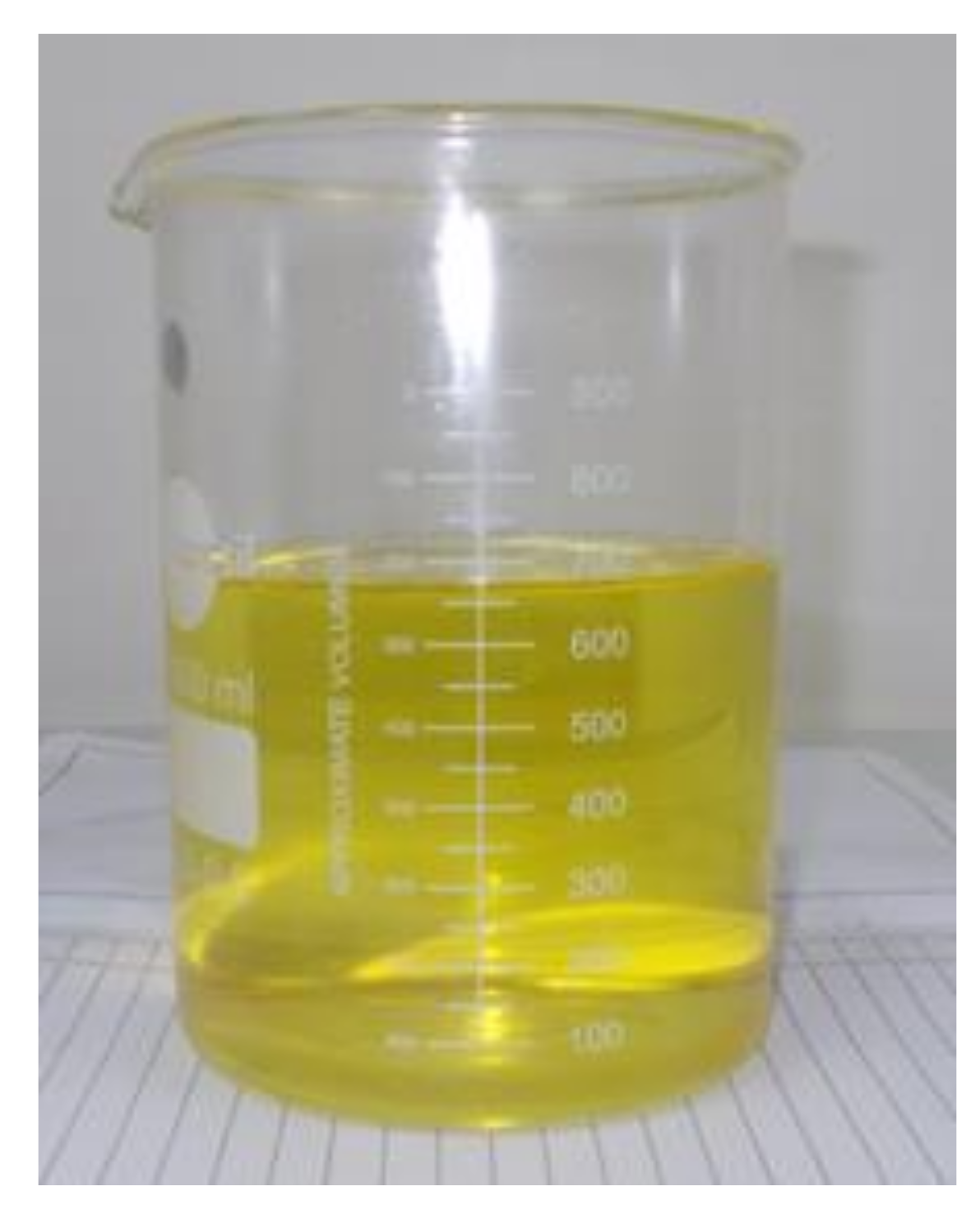
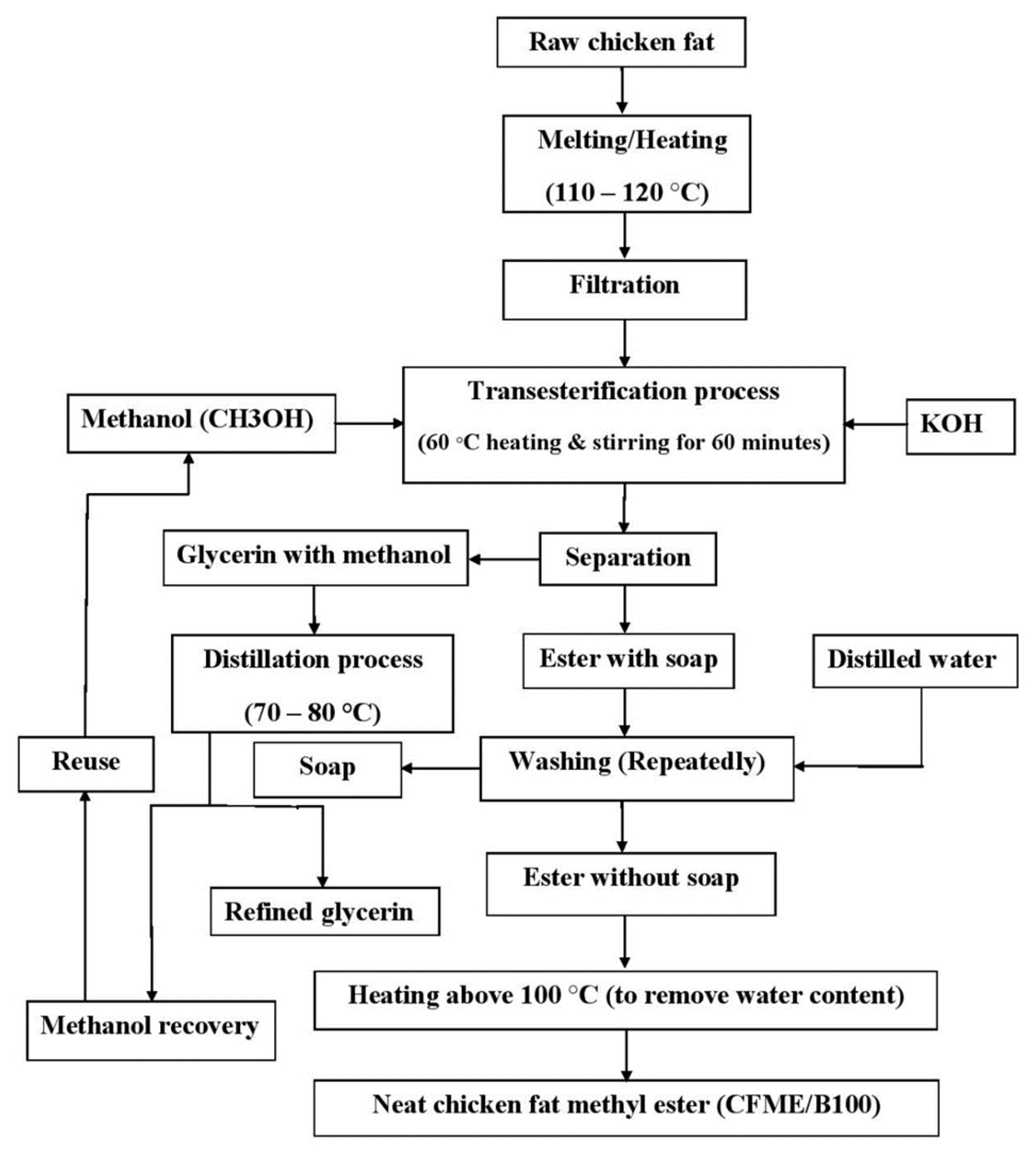
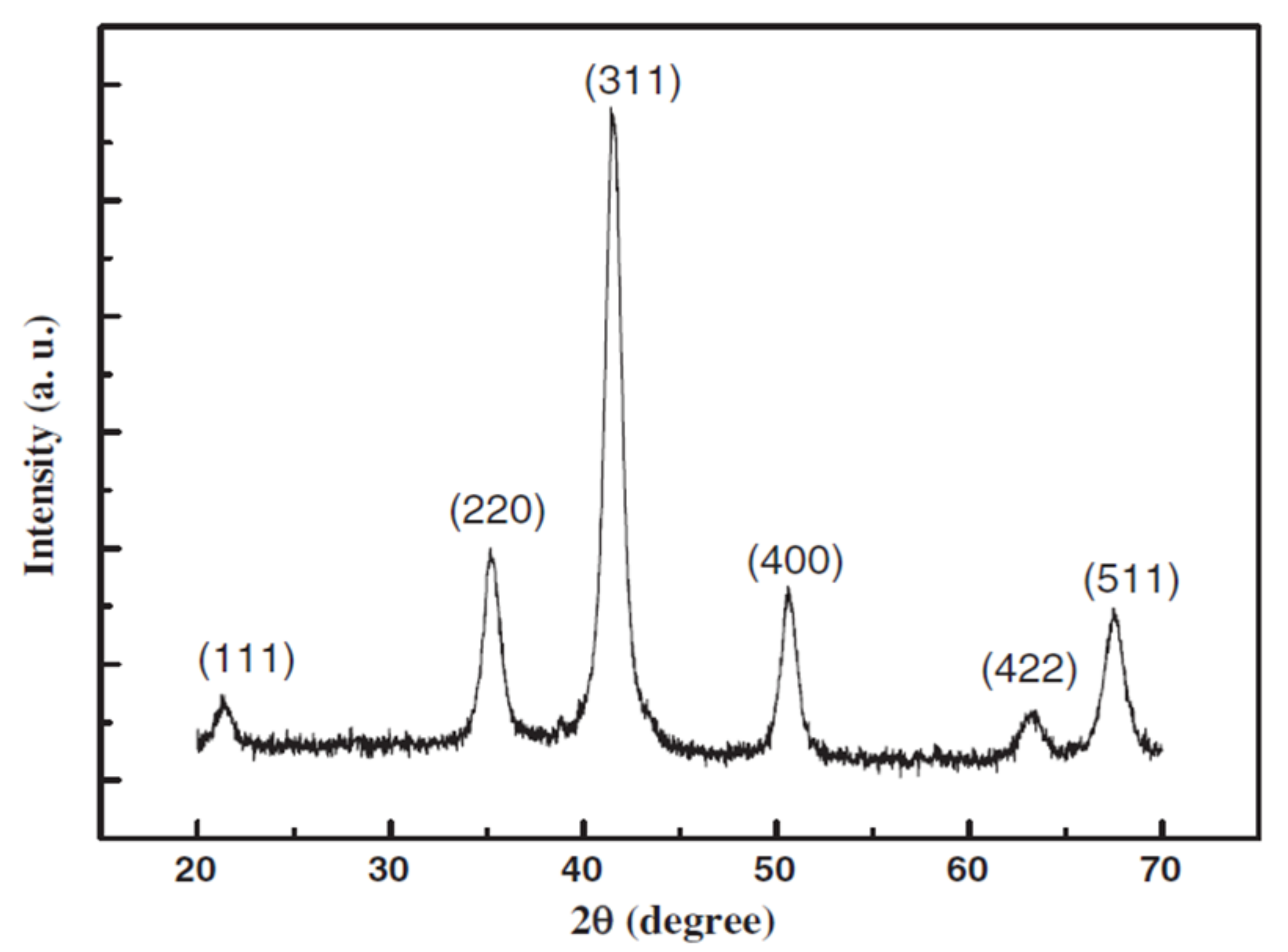
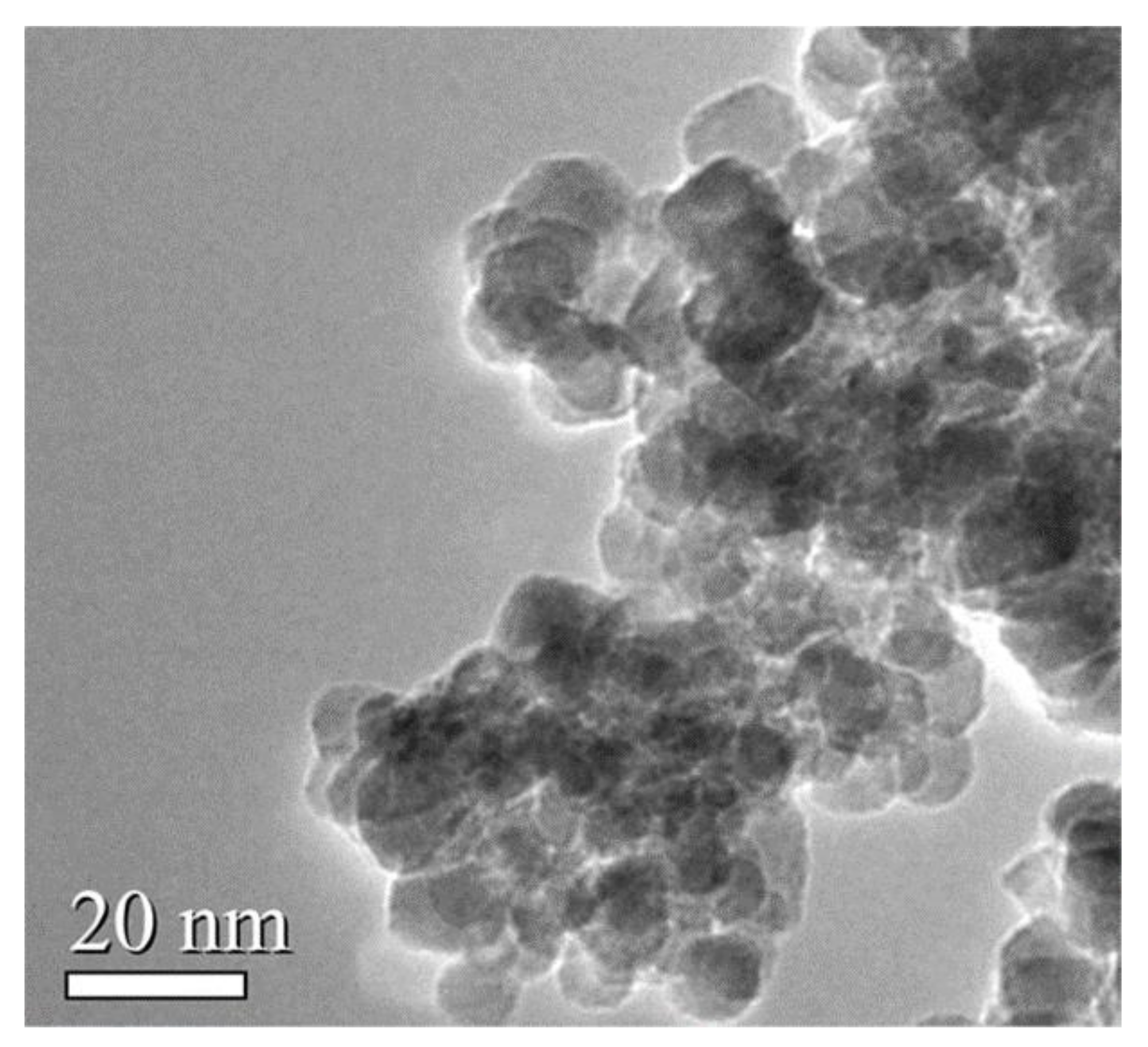
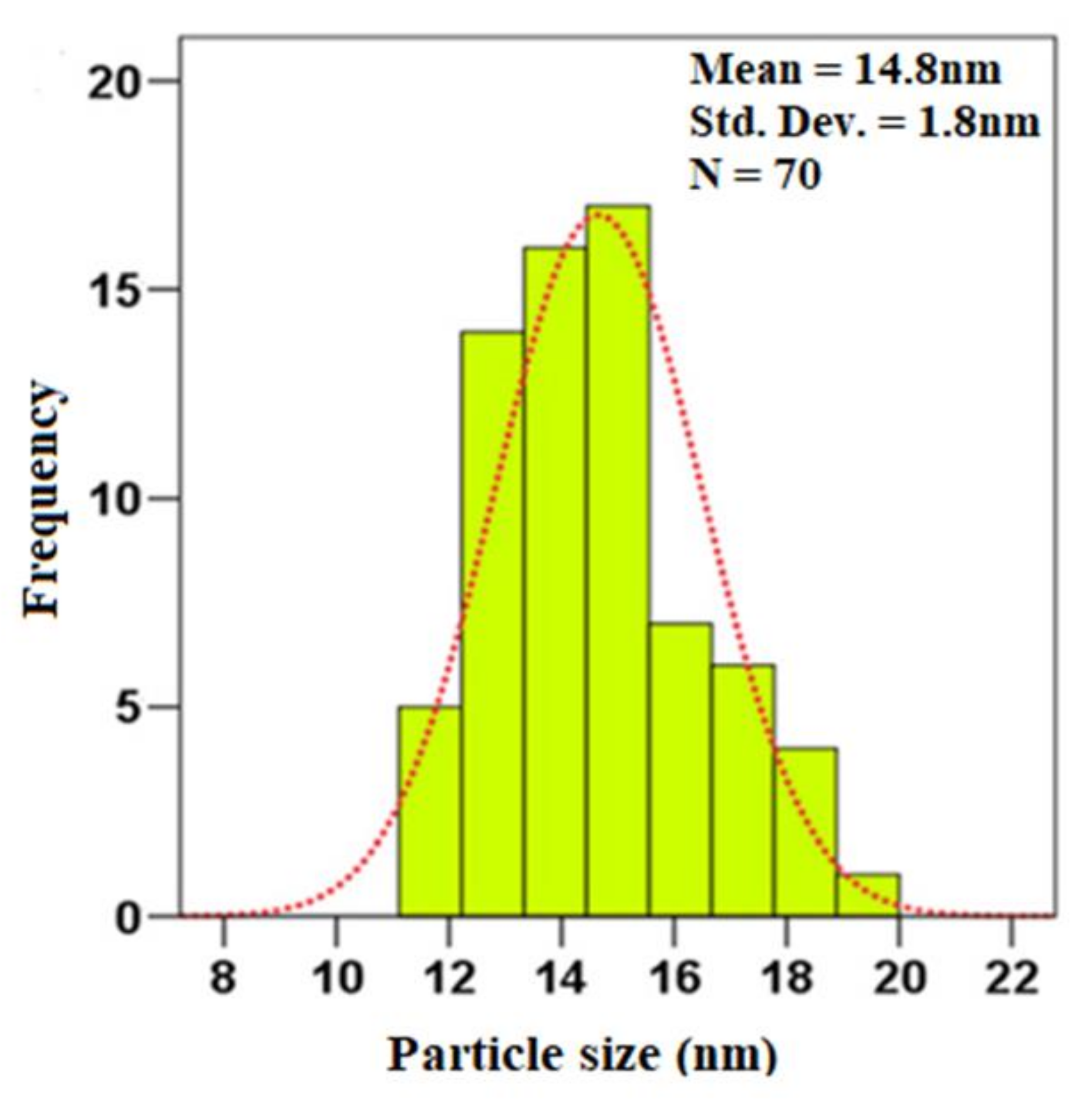
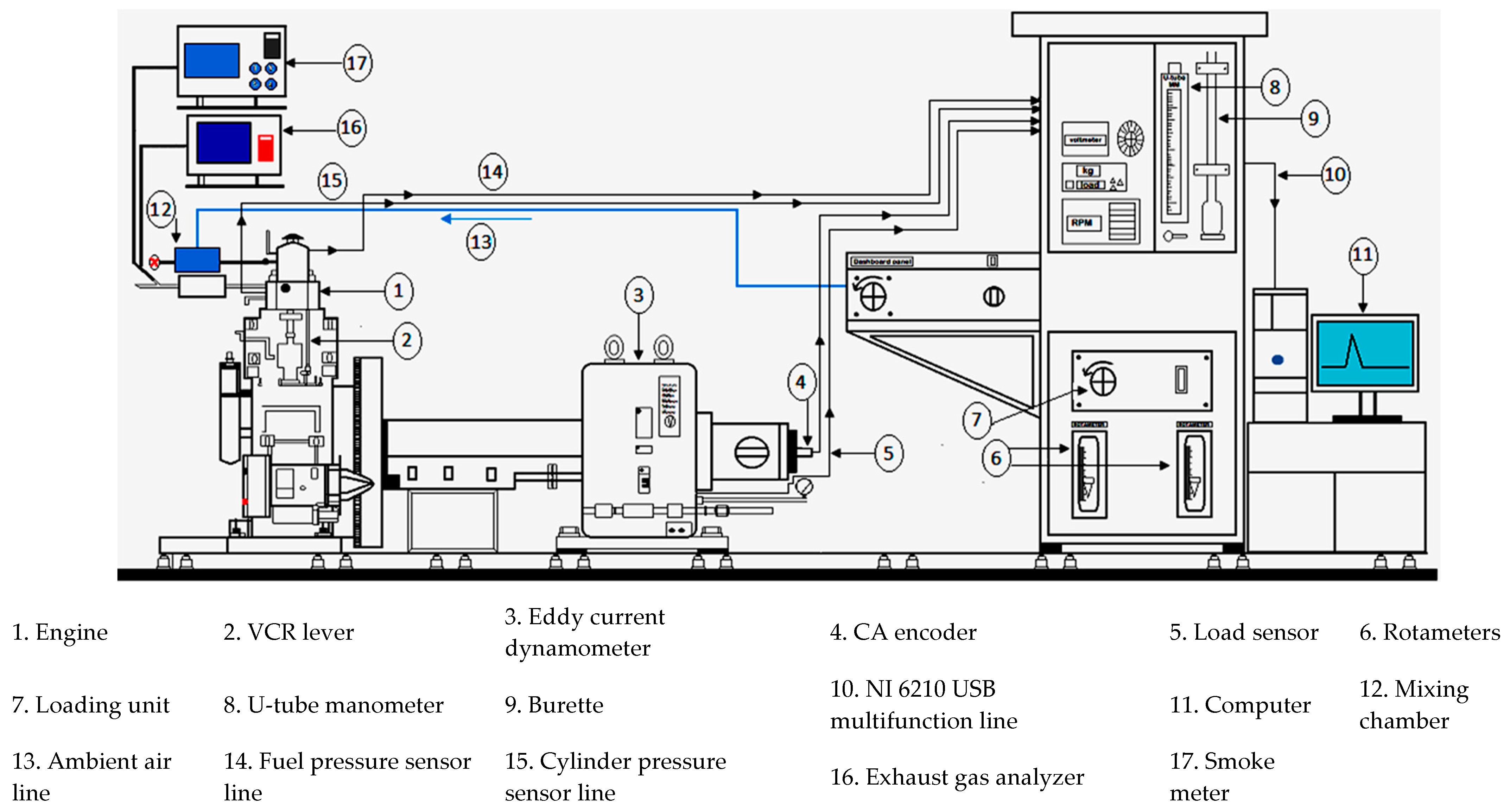

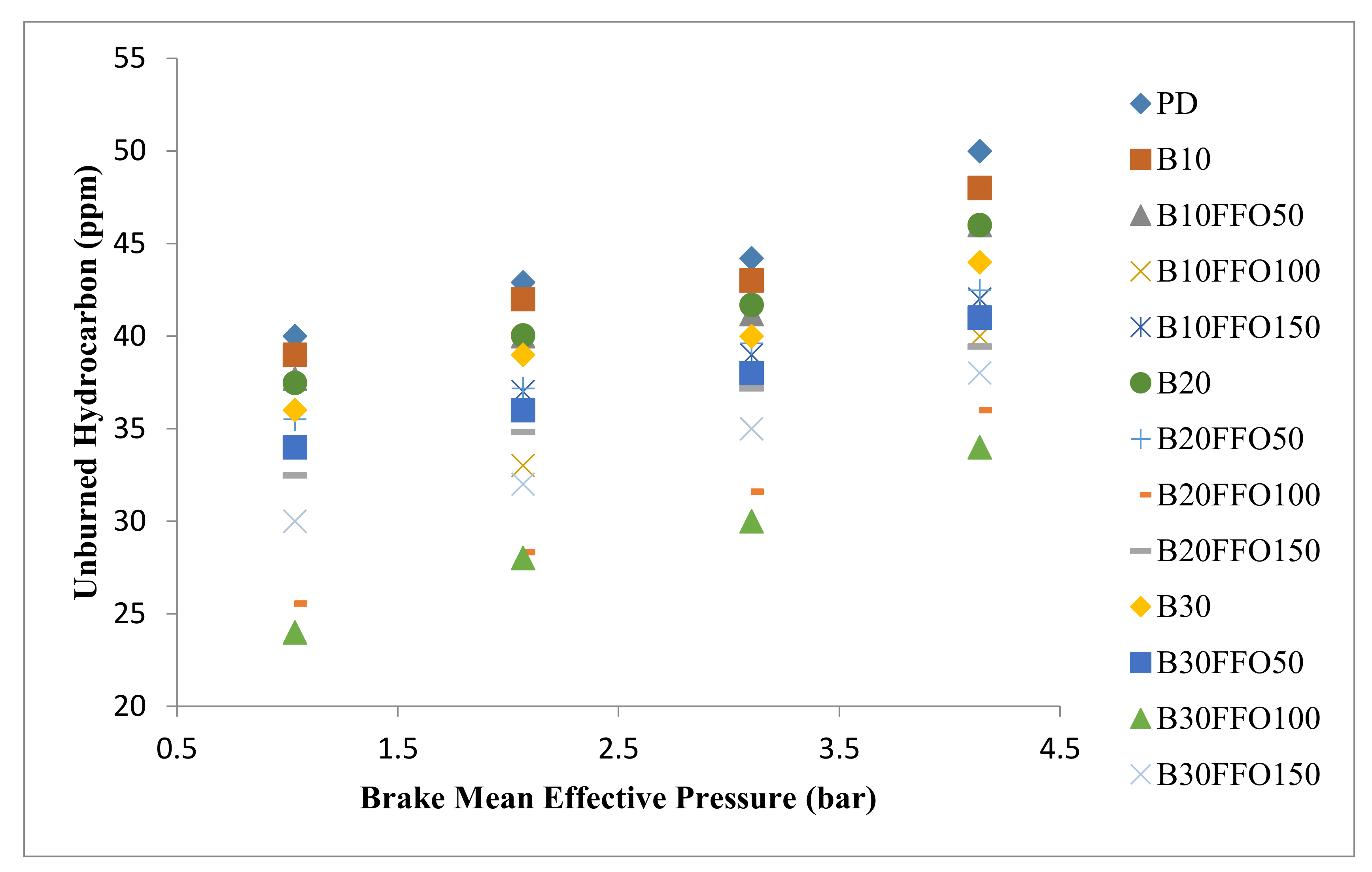


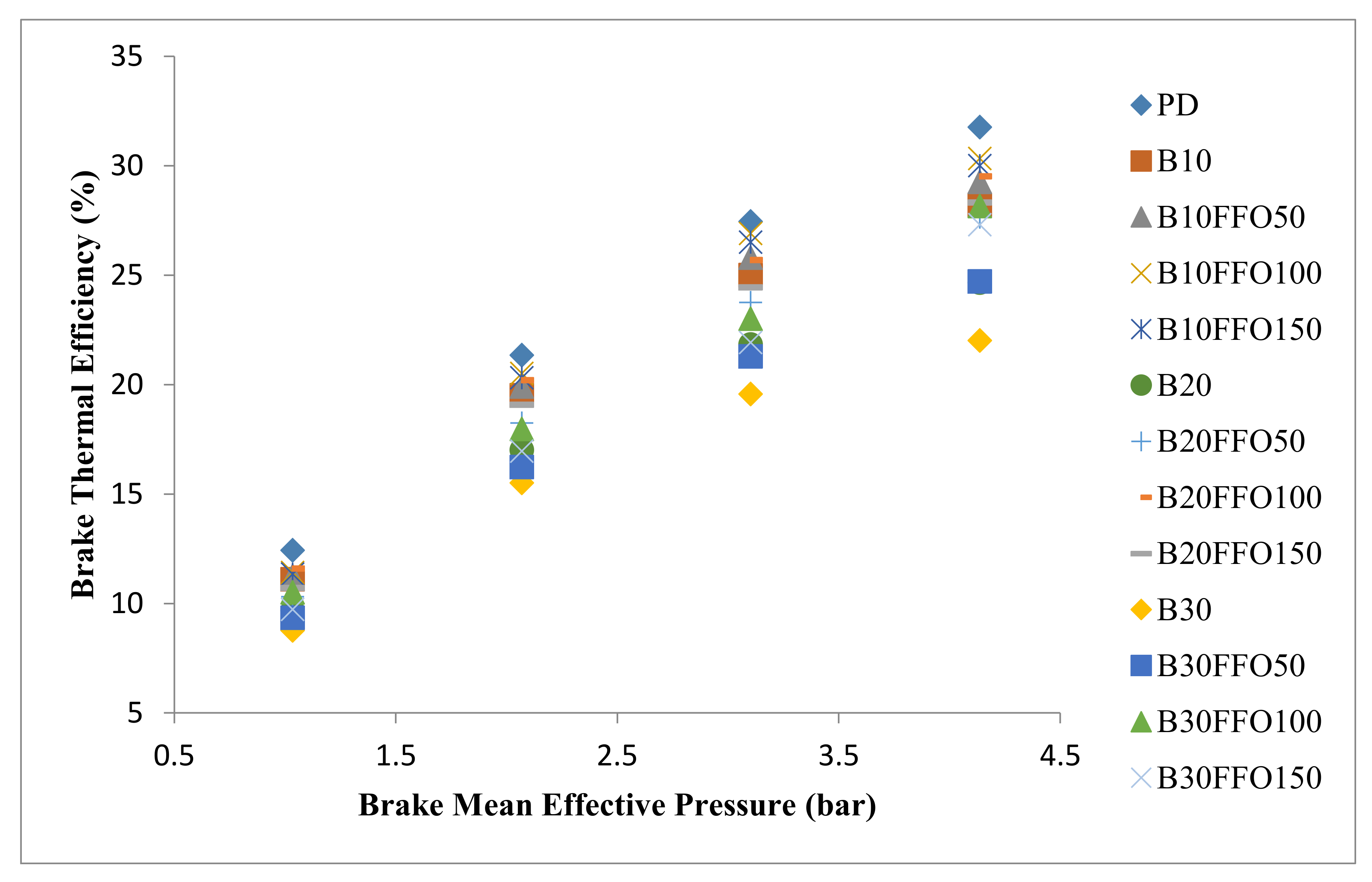


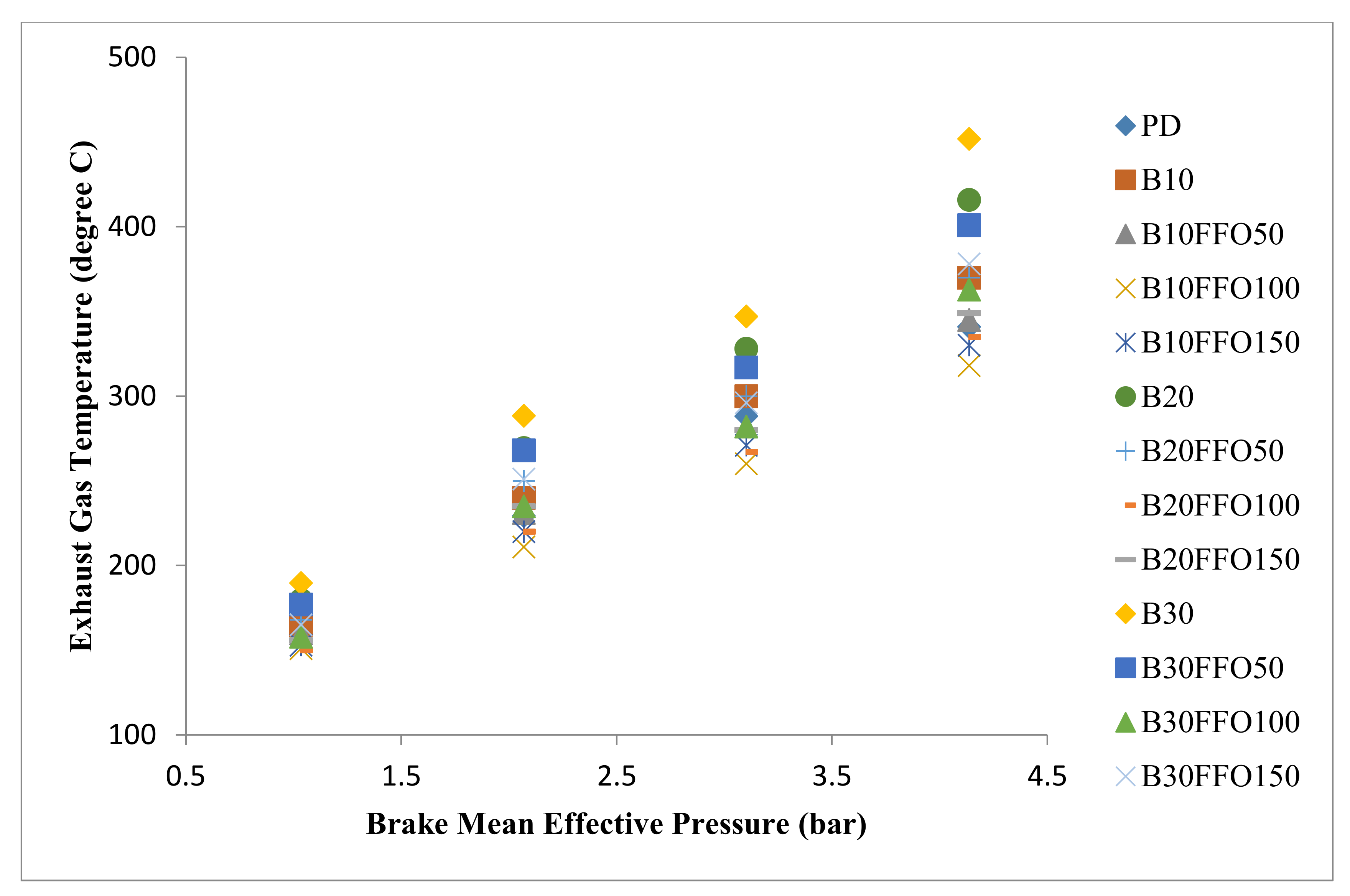
| Fatty Acid Composition | Carbon Number | Chemical Formula | Wt.(%) |
|---|---|---|---|
| Myristic | C14:0 | C14H28O2 | 0.74 |
| Palmitic | C16:0 | C16H32O2 | 22.30 |
| Palmitioleic | C16:1 | C16H30O2 | 8.19 |
| Stearic | C18:0 | C18H36O2 | 5.40 |
| Oleic | C18:1 | C18H34O2 | 42.47 |
| Linoleic | C18:2 | C18H32O2 | 19.30 |
| Linolenic | C18:3 | C18H30O2 | 1.02 |
| Eicosenoic | C20:1 | C20H38O2 | 0.43 |
| Notations | Density (g/cc) | Viscosity (cSt) | Flash Point (°C) | Fire Point (°C) | Cetane Value | Calorific Value (MJ/kg) |
|---|---|---|---|---|---|---|
| PD | 0.840 | 2.58 | 71 | 75 | 46.0 | 43 |
| CFME | 0.8754 | 4.94 | 160 | 170 | 57.8 | 40.427 |
| B10 | 0.8435 | 2.81 | 80 | 85 | 47.2 | 42.742 |
| B20 | 0.8479 | 3.05 | 89 | 94 | 48.4 | 42.485 |
| B30 | 0.8507 | 3.29 | 98 | 103 | 49.5 | 42.228 |
| B10FFO50 | 0.8443 | 2.85 | 78 | 82 | 49.2 | 43.020 |
| B20FFO50 | 0.8483 | 3.09 | 87 | 92 | 50.3 | 42.761 |
| B30FFO50 | 0.851 | 3.33 | 94 | 101 | 51.4 | 42.502 |
| B10FFO100 | 0.8449 | 2.89 | 77 | 81 | 50.5 | 43.319 |
| B20FFO100 | 0.8488 | 3.13 | 85 | 90 | 51.7 | 43.059 |
| B30FFO100 | 0.8518 | 3.37 | 91 | 97 | 52.8 | 42.798 |
| B10FFO150 | 0.8457 | 2.95 | 78 | 82 | 52.0 | 43.250 |
| B20FFO150 | 0.8492 | 3.18 | 86 | 91 | 53.4 | 42.980 |
| B30FFO150 | 0.8527 | 3.54 | 93 | 98 | 54.6 | 42.719 |
| Parameters | Specifications |
|---|---|
| Type/Configuration | Vertical, 4-stroke diesel engine, totally enclosed |
| Make | Kirloskar |
| Model | TV 1 |
| No. of cylinders | One |
| Type of Ignition | Compression ignition |
| Type of cooling | Water cooled |
| Rated power | 3.5 kW @ 1500 rpm |
| Bore x stroke | 87.5 mm × 110 mm |
| Crank radius | 55 mm |
| Connecting rod length | 234 mm |
| Variable compression ratio | 12:1 to 18.5:1 (standard compression ratio: 17.5) |
| Peak pressure | 76 bar |
| Swept volume | 661 cc |
| Clearance volume | 40.1 cc |
| Cavity volume at piston top | 34.0 cc |
| Combustion system | Direct injection |
| Injection pressure | 200 bar |
| Injection timing | 23° CA bTDC |
| Combustion chamber | Hemispherical shape |
| Orifice diameter | 20 mm |
| Nozzle orifice diameter | 0.3 mm |
| Aspiration | Natural aspiration |
| Parameters | Measurement Range | Accuracy (±) | % Uncertainty |
|---|---|---|---|
| Speed (rpm) | 0–10000 | ±10 | ±0.1 |
| Load (Nm) | 0–500 | ±0.1 | ±0.2 |
| Time (s) | - | ±0.2 | ±0.2 |
| BP (kW) | 0–50 | ±0.5 | |
| BTE (%) | - | ±0.3 | ±0.4 |
| BSFC (g/kw·h) | - | ±5 | ±0.4 |
| CO (% vol.) | 0–10 | ±0.03 | ±1.5 |
| UHC (ppm) | 0–2000 | ±5 | ±1.4 |
| NOx (ppm) | 0–5000 | ±10 | ±1.5 |
| Smoke (HSU) | 0–100 | ±1 | ±0.9 |
| EGT (°C) | 0–400 | ±2 | ±0.8 |
Publisher’s Note: MDPI stays neutral with regard to jurisdictional claims in published maps and institutional affiliations. |
© 2021 by the authors. Licensee MDPI, Basel, Switzerland. This article is an open access article distributed under the terms and conditions of the Creative Commons Attribution (CC BY) license (http://creativecommons.org/licenses/by/4.0/).
Share and Cite
Suhel, A.; Abdul Rahim, N.; Abdul Rahman, M.R.; Bin Ahmad, K.A.; Teoh, Y.H.; Zainal Abidin, N. An Experimental Investigation on the Effect of Ferrous Ferric Oxide Nano-Additive and Chicken Fat Methyl Ester on Performance and Emission Characteristics of Compression Ignition Engine. Symmetry 2021, 13, 265. https://doi.org/10.3390/sym13020265
Suhel A, Abdul Rahim N, Abdul Rahman MR, Bin Ahmad KA, Teoh YH, Zainal Abidin N. An Experimental Investigation on the Effect of Ferrous Ferric Oxide Nano-Additive and Chicken Fat Methyl Ester on Performance and Emission Characteristics of Compression Ignition Engine. Symmetry. 2021; 13(2):265. https://doi.org/10.3390/sym13020265
Chicago/Turabian StyleSuhel, Ameer, Norwazan Abdul Rahim, Mohd Rosdzimin Abdul Rahman, Khairol Amali Bin Ahmad, Yew Heng Teoh, and Noh Zainal Abidin. 2021. "An Experimental Investigation on the Effect of Ferrous Ferric Oxide Nano-Additive and Chicken Fat Methyl Ester on Performance and Emission Characteristics of Compression Ignition Engine" Symmetry 13, no. 2: 265. https://doi.org/10.3390/sym13020265
APA StyleSuhel, A., Abdul Rahim, N., Abdul Rahman, M. R., Bin Ahmad, K. A., Teoh, Y. H., & Zainal Abidin, N. (2021). An Experimental Investigation on the Effect of Ferrous Ferric Oxide Nano-Additive and Chicken Fat Methyl Ester on Performance and Emission Characteristics of Compression Ignition Engine. Symmetry, 13(2), 265. https://doi.org/10.3390/sym13020265






